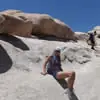Leave No Trace is an eco-friendly movement taking shape and gaining popularity with naturalists and environmentalists everywhere. As more people get outdoors for camping, hiking, and exploring, the environment takes more of a beating.
The Leave No Trace Center for Outdoors Ethics has set forth these seven principles in hopes that, if everyone enjoys the wilderness responsibly, nature will stay just the way we love it: pure and intact.
1. Plan Ahead and Prepare
Before heading out, it's important to brush up on local regulations, possible extreme weather conditions and particular regional concerns. And, instead of traveling in a large group, go with fewer people, at times when there is the least amount of seasonal use.
More: How to Plan a Camping Trip in 3 Steps
2. Travel and Camp on Durable Surfaces
Durable surfaces are defined as established trails and campsites. For primitive campers, set up a minimally sized camp, to leave as small a footprint as possible. Whether traveling on established trails or not, walk in a single file line and avoid going off to the sides.
3. Dispose of Waste Properly
Just remember this motto: pack it in, pack it out. "Leave no trace" means the campsite looks like it did when you arrived, whether you're at an established campground or not. Dispose of human waste in holes that are 6 to 8 inches deep and 200 feet away from water, at least. Stay this far from water or streams when washing yourself or dishes, as well.



